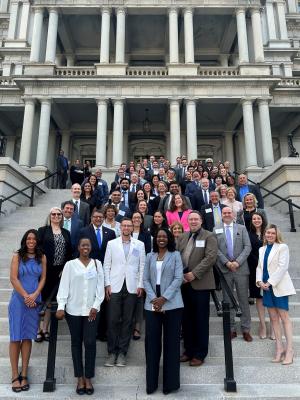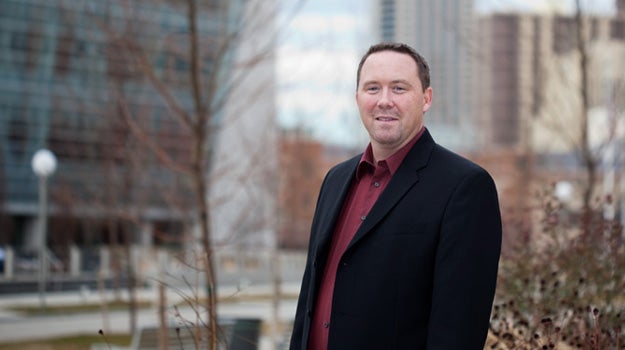Five questions for Chad Morris
Chad Morris’ early career was split between clinical research on the treatment of bipolar disorder and schizophrenia, and state-level behavioral health policy work focusing on community integration, recovery services and homelessness. Then, in 2001, the professor of psychiatry in the School of Medicine at the CU Anschutz Medical Campus had what he calls “a transformative experience.”
“I had the opportunity to perform a state tobacco cessation needs assessment for persons with mental illnesses,” Morris said. “As a clinician, I had worked in many different inpatient, outpatient and residential treatment settings, and had never given a second thought to clients’ ubiquitous smoking. Through the needs assessment, people were open about their struggles with quitting smoking, that they desired to quit, but that there was a severe lack of access to tobacco use treatment. I also learned about the staggering loss of life and human potential due to smoking.”
That’s when Morris began questioning many of the myths surrounding tobacco use in the behavioral health population: that people with mental illness need to smoke to control symptoms, they don’t want to quit, or if they did want to quit, they wouldn’t be able.
“This led to a personal ‘a-ha’ moment,’” Morris said. “What is the point of integrating individuals into communities and providing cutting-edge psychiatric services if they are just going to die or be disabled from smoking and other leading causes of death such as metabolic syndrome?
“It became very clear to me that all health and behavioral health systems have roles in addressing the whole-health needs of persons facing health disparities. For persons with mental illnesses and addictions, tobacco use treatment is an essential aspect of many people’s recovery journey.”
This realization led Morris down a whole-health path and his creation of the Behavioral Health and Wellness Program, a national program focused on well-being of health disparity populations as well as interdisciplinary providers. What he calls the program’s “small but mighty multidisciplinary team” works to facilitate behavior change at the individual level and health systems change at the organizational and community levels.
1. You established the Behavioral Health and Wellness Program in 2006. How has the program evolved over time?
My team’s work and that of many national and international colleagues have led to measurable change when it comes to addressing the tobacco cessation needs of the persons with behavioral health conditions. There is still much work we hope to do in this area, and at the same time, my vision for the Behavioral Health and Wellness Program was always broader in terms of populations served and wellness topics covered.
My experience is that, if you open multiple doors to wellness, there is always some aspect of personal wellness in which individuals are interested. When we talk about wellness, it is natural to instantly think of physical or emotional well-being. These topics are key to health, but our well-being encompasses many dimensions including environmental, social, intellectual, occupational, financial and spiritual. Our interest is to collaboratively work with individuals and organizations to identify what area of wellness they want to focus on and then start to build self-efficacy by creating realistic change goals. When it comes to work and well-being, one size does not fit all.
We have now partnered with almost all states through federally funded projects and networks, or individual contracts with state departments, health care, behavioral health and public health organizations. In this work, we take a parallel track. Our goal is to reach priority populations that often don’t have access to the services they need, including people with behavioral health conditions; people who are justice-involved; low-income populations; those living in rural regions; people who experience homelessness; communities of color; the LGBTQIA+ community; pregnant and perinatal mothers; youth and young adults.
And we believe strongly that there must also be a focus on workforce wellness. Providers cannot provide effective services if their wellness needs aren’t also a focus. We have had the opportunity to work with small and large health care and public health systems to increase individual wellness through organizational health systems change efforts. Most recently in Colorado, Gov. Polis allocated funding to address the statewide resiliency needs of health care and public health workers, and we are excited to have been one of two recipients of CO-CARES grants.
2. CO-CARES is a new program that launched last month. How does the program work and how will you put the grant to use?
CO-CARES stands for the Colorado Alliance for Resilient and Equitable Systems serving the health care and public health workforce. The Colorado Department of Public Health and Environment launched the initiative to help support the health care and public health workforce who helped Colorado through the pandemic — and continue helping every day.
Our goal is to bridge the gap between health care and public health workers and the resources they need to support their and their organizations’ well-being and resilience. CO-CARES is made possible because of an incredible alliance with the University of Colorado Department of Psychiatry, University of Colorado Colorado Springs’ Lyda Hill Institute for Human Resilience, the Colorado Hospital Association, the Switchback Institute, and the Colorado School of Public Health.
My team provides wellness consultation across the nation, and this is by far the largest initiative I’ve seen to provide a menu of services and supports that are tailored to individual need. All health care and public health workers — from the bedside to support services to executive leadership — deserve to prioritize their well-being. The Behavioral Health and Wellness Program’s role is on the organizational leadership and management level. We are consulting with a broad spectrum of statewide organizations, including EMS, hospitals, long-term care, behavioral health, primary care and local public health agencies to identify rapid improvement goals and identify no-cost CO-CARES training, programming and technological resources aligned with those goals.
In addition, we are providing a virtual leadership learning series, and will be offering statewide office hours by health care sector. These facilitated calls will allow you to dialogue with peers in similar sectors regarding barriers to building a wellness culture and organizational solutions. We have been running similar national office hours for behavioral health organizations for over a decade, and I am continually energized by the innovation that these peer-to-peer sessions generate. If anyone is interested in CO-CARES, please reach out to me.
3. You recently took part in a White House forum as part of the administration’s Cancer Moonshot. What was that experience like and what takeaways did you return with?

I was honored to be invited to the White House for small group moderated discussions on moving beyond known barriers and into the solutions necessary to decrease preventable cancers. President Biden and first lady Jill Biden reignited the Cancer Moonshot in 2022 with the goal of reducing the cancer death rate by 50% over the next 25 years and improving the experience of individuals, caregivers and families living with and surviving cancer. As part of the State of the Union earlier this year, the Biden-Harris Administration committed to expand smoking cessation services for Americans who want to access them.
This event was a call to action for participants to advance smoking cessation within their work and in collaboration with others. We were each asked to share what we viewed as a top solution. I emphasized helping communities build “person-centered whole health neighborhoods” to open multiple doors to health, community and a meaningful life. Using this model, we meet persons facing health disparities where they already live, work, socialize and receive services.
I had a few major takeaways from this experience. This was a reminder that, if interested, we can all have a voice in our political system. There is a real opportunity to have an “upstream” impact in terms of agenda, funding and the real-world barriers faced by those we serve. The Cancer Moonshot is most recently informed by the COVID Moonshot and the ability of an open-science consortium from around the world to discover safe, globally affordable and easily manufactured antiviral drugs in an incredibly small amount of time.
The idea of a moonshot as such an ambitious, exploratory and groundbreaking project has stuck with me. I am now asking myself, what are my own personal and professional audacious goals? And how can I foster and support collaborations that allow for movement beyond my comfort zone?
This event also reinforced my interest in the potential of public-private partnerships to accelerate innovation. As health professionals in such partnerships, I believe our roles will necessarily increase in advocating for equitable access, ensuring that care is evidence-based, and adhering to our professions’ ethical standards.
4. You mentioned the idea of a “person-centered health neighborhood.” What exactly is that?
An underlying theme of our team’s work is to address health disparities in a sustainable fashion by meeting people where they are. There is the concept of a patient-centered medical home where primary care is the hub of services for patients. Unfortunately, due to a myriad of factors, many individuals can’t easily access primary care or behavioral health care. While these settings are integral components of a continuum-of-care, our team has developed the “person-centered health neighborhood” approach to reach those most in need.
What does this mean? Simply, that we need to serve people at the community hubs where people naturally seek services or interact with one another. In these environments, we increase reach and uptake of services. And within these hubs, our program utilizes trusted community messengers, and peers with lived experience to screen and navigate individuals to resources including primary care, behavioral health treatment and telehealth.
As several examples, we have trained peers with a lived experience of homelessness, justice involvement and/or behavioral health conditions who are employed by the Denver Public Library to screen individuals for chronic illnesses, and then provide warm hand-offs to health and public health services. In Arizona, we recently trained individuals incarcerated in state prisons to administer voluntary, pre-release wellness services. We have had the pleasure of directly training tens of thousands of professionals, community health workers and peer specialists in this care model.
5. You’re a member of the Motivational Interviewing Network of Trainers. What does that work entail?
Motivational interviewing is a collaborative conversation style for strengthening a person’s own motivation and commitment to change and healthy decision making. We can become very set in our behaviors. Change is difficult and ambivalence about change is the norm. The focus of MI is to enhance motivation.
With MI we approach people with the underlying perspectives of partnership, acceptance, compassion and evocation, which is the identification of individual strengths and resources. MI isn’t about taking immediate action. While there is almost always a desired behavioral outcome providers have in mind, acting isn’t the focus of an MI conversation. Instead, this work entails preparing people for engaging in evidence-based care.
In our action-oriented culture, it’s easy to skip over the necessary step of preparing for change. In health care environments, given the little time providers have and their many competing demands, it is easy to jump to advising patients without first listening to patients and then having a collaborative conversation. But as MI research has repeatedly shown, we are more efficient when we take the time to relate to and engage with others.
In this case, patients will share their thoughts and experiences with providers, listen to their ideas and return for treatment. Through our MI Institute, my team has trained a wide variety of professionals and leaders in MI. The MI skill set is a core ingredient of our organizational consultation where the client may be the leadership team rather than the end-user.
What is both energizing, challenging and sometimes frustrating about MI, like other clinical skills, is that there is never a finish line. While a perpetual practice, there is always something new and exciting to learn when I remind myself to really listen to others.


